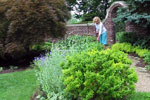
Sewickley Tour Offers Glimpse at Early 1900s Garden
By Joanne Braun
SEWICKLEY HERALD
Thursday, June 17, 2010
When Janice and Ronald West moved into their Sewickley Heights home 15 years ago, remnants of the past scattered the property.
One such remnant is an old cherub statue perched in the middle of The Gardens of Poplar Hill on the Country Club Road property. It will be included in the Sewickley Civic Garden Council’s garden tour Friday.

Sewickley Civic Garden Council's garden tour on Friday includes five private gardens within a few blocks of the Edgeworth Club, and a sixth, The Gardens of Poplar Hill in Sewickley Heights, adjacent to Allegheny Country Club. Carolyn Smith, garden tour event coordinator, checks out a few specimens at the Poplar Hill gardens. Joanne Braun | Sewickley Herald
The cherub, which sits in the lower garden, is surrounded by plants, shrubs, brick walls, black iron gates and a roofed summer house, all dating back to the early 1900s. The garden is being cataloged as a historic garden for the Smithsonian Institution in Washington. Village Garden Club’s Garden History and Design committee provided research and documentation — the first time the club, which is a member of the Garden Club of America, has attempted such an undertaking.
Committee members Cathy Snyder, Cordelia Jacobs, Alisa Lenhardt and Lisa Burrows will send their work to the club’s Garden Club of America’s zone coordinator in Philadelphia. Once the research and photos are approved, it will be sent to the Smithsonian for inclusion in the Archives of American Gardens.
Kelly Crawford, museum specialist at the Smithsonian, said the Archives of American Gardens collection captures more than 6,500 American gardens in 80,000 images, historic records, illustrations and plans.
“Some of these records fix a moment in the life of an existing garden, and others describe gardens that are no longer in existence,” she said.
Snyder said Arthur Shurcliff, a member of an architectural firm that became famous for its garden designs, designed the original landscaping at Poplar Hill in 1914.
The property once featured a 35-room carriage house, which later was torn down by a new owner. The property housed numerous families over the years who added structures, sold off some of the land and subdivided it.
In 1948, The Gardens of Poplar Hill were chosen as featured gardens at the Garden Club of America annual meeting. It was part of a tour sponsored by Pittsburgh History and Landmarks Foundation in 1997.
When the Wests moved in, they refurbished much of the deteriorating brickwork, rehung the iron gates, reconstructed and refurbished the limestone windows within the brickwork, and replaced the roof and copper gutters on the summer house.
At that time, most of the flower beds were empty. Poplar trees, for which the property was named, once grew outside the brick walls but were lost to disease in the 1960s.
“There were very little perennials left. We had to start over with the plantings,” Janice West said.
However, large specimen trees, bushes and hedges still flourished throughout the property, and peonies and Japanese iris remained in the lower garden.
As visitors enter the lower garden, they can walk on pathways of blue slate and pea gravel that wind around the inside courtyard. Niches with two Japanese statues, with shallow pools in front of each, face one another across the courtyard.
Also featured are blue spruce and juniper surrounding the side of the house. Dark green boxwood blends with the softer pastel hues of Russian sage and astilbe. Not far away are colored foxgloves and coneflowers mixing with japonica and peonies. Blue geraniums and Japanese grass also make a home in the garden.
“I try to repeat some of the same plants in different spots,” West said.
The couple purchased and placed stone urns to replicate those in photographs from the 1930s atop two brick pillars closer to the house.
Nearby are more large shrubs, which were not there in the original landscape.
“There used to be lillies and flowers along the way. This was just a walkway to the house. I thought about taking the bushes out, but they are so mature,” West said.
As visitors continue to the back of the house, they will get a view of the Allegheny Country Club’s fairways and clubhouse.
That side of the house features an added greenhouse and a large birdbath along with a horseshoe hedge of yews believed to be part of the original landscape. The Wests added more mature yews to the hedges to complete the horseshoe shape, which now surrounds the original English wellhead and two large swamp cypresses. Janice West planted a vegetable garden on the eastern side of the house in the rear, near to where other such gardens originally grew. Plants are held up by trellises of different colors.
In a document prepared for the Smithsonian, committee members wrote, “Without question, Poplar Hill remains a significant treasure in garden design. The fact that it is in the hands of genuine enthusiasts who understand and appreciate the importance of documenting its evolution, preserving its integrity and sharing its beauty with others bodes well for the future.”
If you go
What: Sewickley Civic Garden Council’s garden tour, including five private gardens within a few blocks of the Edgeworth Club. The sixth, The Gardens of Poplar Hill in Sewickley Heights, is adjacent to Allegheny Country Club.
When: 9 a.m. to 4 p.m. Friday. Jan Godshalk, award-winning floral designer, will present a floral arranging demonstration at a luncheon at the Edgeworth Club from noon to 1:30 p.m.
Cost: $20, or $35 for the demonstration. Lunch not included. A combination ticket for the tour and lecture is $50. Tickets are available in Sewickley at Cuttings, Walnut Street; The Gift Corner, Broad Street; and Penguin Book Store, Spoiled Chics and Cheers, Beaver Street.
For more information: Visit www.sewickleygardens.org.
